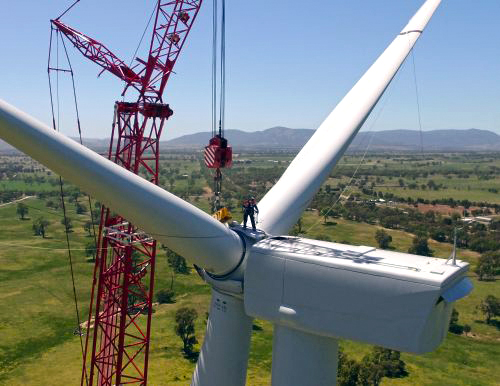The NEG is a dog of an idea, but it’s all we’ve got.

Assembling a wind turbine. PHOTO Ararat Wind Farm, Victoria
Politics is winning hands down over policy in the endless battle for good government in Canberra.
Already damaged by the chronic Turnbull-Abbott divide, last week the government was reeling from the furore over police raids on unions. Then came the High Court citizenship decision.
The Nationals are devastated. Having lost both leader Barnaby Joyce and deputy leader Fiona Nash, they now face having Nash replaced in the Senate by a Liberal – the candidate immediately below her on the Coalition’s 2016 NSW Senate ticket.
To top it off, the present acting PM is foreign minister Julie Bishop, breaking with the internal understanding that the stand-in will always be the Nationals leader. The punishment is complete.
But shed no tears for the Nationals. They have been instrumental in wrecking Australia’s response to the climate crisis and ensuring that Malcolm Turnbull’s “solution”, his National Electricity Guarantee (NEG), is a dog of an idea.
This is said with a heavy heart. Since the abolition of a carbon price in 2014 we have endured a virtual absence of energy and climate policy of any sort in Canberra.
Fading hopes that the dumping of Tony Abbott would see progress were revived when Turnbull combined climate and energy under Josh Frydenberg’s ministry – something both Liberal and Labor administrations had failed to do. But since then, nothing.
In the past year the Coalition has rejected two schemes to put a price on carbon emissions, the latest resulting from their own commissioned inquiry by chief scientist Alan Finkel. The NEG and its “powering forward” promise is its last-gasp attempt to retrieve something of value from the mess.
As it stands, the NEG is barely a band-aid over the festering wound of Coalition climate politics. To even begin to “power forward” it needs agreement from the Council of Australian Governments, which will be a challenge with key states already expressing disapproval.
The Australian Energy Market Commission has been charged with making NEG work, but it represents big generators and is ill-equipped to have the running on our central climate measure. We won’t know how successful it has until well after the next election, whenever that may be.
Investors need targets locked in at least 25 years ahead, but the government still has no long-term emissions target. That severely constrains the roll-out of electricity infrastructure of any kind – including Turnbull’s favoured “clean” option, pumped Snowy Mountains hydro.
Snowy Hydro chief executive Paul Broad told a Senate inquiry last week that building a pumped hydro scheme would involve removing 10 million cubic metres of rock from “challenging” rock formations, and Fairfax media reported that the scheme’s $2 billion price-tag did not include new transmission lines, costing about the same again, required to deliver the extra electricity into Sydney and Melbourne.
Since the government announced NEG a fortnight ago – it seems an eternity – it has failed to explain how different sectors of the energy market might fare under the scheme. Without modelling it’s not possible to define, let alone promise, affordability and reliability.
Questions abound. Why is coal power, which takes hours to switch on, listed as “dispatchable” – able to be made available quickly to meet demands? And how will that conveniently loose definition affect investment in wind and solar?
If past statements are any guide, the AEMC will continue to favour what it knows: current synchronous (coal, gas) technology. A key question is, what will be its attitude to asynchronous sources such as solar and wind using batteries and smart-grid technology?
Contrary to what Coalition politicians have been saying about “reliable baseload” energy and “unreliable, intermittent” wind and solar, proven asynchronous technology makes wind and solar as reliable as synchronous generation while responding much more rapidly to changing demands.
Don’t expect to hear that from the government. To the contrary, Senator Matt Canavan, fresh from High Court vindication over his citizenship and back in his old job as resources minister, is pushing hard for a new coal-fired power station in North Queensland.
After being sworn in he said he saw “no reason” why such a development could not be funded by the government’s Northern Australia Infrastructure Fund, adding for good measure that NAIF could also fund a railway line for Adani’s proposed Carmichael coal mine.
That would be the only way for either of these ideas to see the light of day. “There is no current investment appetite to develop new coal-fired power in Australia,” Matthew Warren, chief executive of the Australian Energy Council, said in February, and that remains the AEC’s position.
Only flat-earthers and rusted-on coal devotees could believe that mining and burning more coal for energy is a good idea. It would demand unrealistic levels of abatement in other sectors, notably transport and land management, if we were to meet even our weak Paris target.
As it stands the NEG is no solution to anything, but it’s all that’s on offer. We’re running out of time, and there seems a reasonable prospect that it can be tweaked and augmented to have an impact on emissions. On that basis, and only on that basis, it should go ahead.
